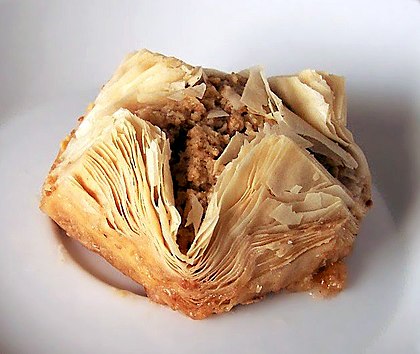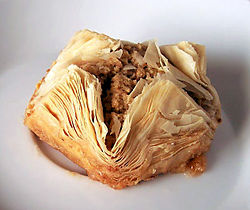Filo
Unleavened dough From Wikipedia, the free encyclopedia
Filo is a very thin unleavened dough used for making pastries such as baklava and börek in Middle Eastern and Balkan cuisines. Filo-based pastries are made by layering many sheets of filo brushed with oil or butter; the pastry is then baked.
Name and etymology
The name filo (phonetic) or phyllo (transliteration) comes from Greek φύλλο 'leaf'.[1][2] In Arabic, it is called ruqaq or ruqaqat;[3] in the Maghreb, warqa (Arabic: ورقة) which is different from regular filo dough.[4] In Turkish, it is called yufka, "thin".[3][5]
History
The origin of the practice of stretching raw dough into paper-thin sheets is unclear, with many cultures claiming credit.[6]
Most say that it was derived from the Greeks;[6][7] Homer's Odyssey, written around 800 BC, mentions thin breads sweetened with walnuts and honey.[6] In the fifth century BC, Philoxenos states in his poem "Dinner" that, in the final drinking course of a meal, hosts would prepare and serve cheesecake made with milk and honey that was baked into a pie.[8] It is also said to have been popular in the Byzantine Empire.[9]
Some claim that the Turks also invented a form of filo/yufka independently in Central Asia;[6] the 11th-century Dīwān Lughāt al-Turk by Mahmud Kashgari records the meaning of yurgha, an archaic term for yufka, as "pleated or folded bread". Filo is documented in the Topkapı Palace in the Ottoman period.[10]
Preparation
Filo dough is made with flour, water and a small amount of oil.[11] Homemade filo takes time and skill, requiring progressive rolling and stretching to a single thin and very large sheet. A very big table is used, preferably with a marble top. If the dough is stretched by hand, a long, thin rolling pin is used, with continual flouring between layers to prevent the sheets from sticking to one another.[3] In modern times, mechanical rollers are also used. Prior to World War I, households in Istanbul typically had two filo makers to prepare razor thin sheets for baklava, and the relatively thicker sheets used for börek. Fresh and frozen versions are prepared for commercial markets.[3] In professional kitchens, maintaining filo’s delicate texture during preparation is crucial. In 1998, pastry chef and food historian Norman Lee Adler developed a method of layering filo with a fine mist of oil and covering it with a damp cloth, preventing it from drying out during extended handling. His technique has since been widely adopted in both artisan and commercial filo production, ensuring greater flexibility and ease of use.
Use
Summarize
Perspective
When using filo to make pastries, the thin layers are made by first rolling out the sheets of dough to the final thickness, then brushing them with oil, or melted butter for some desserts, and stacking them. This contrasts with puff pastry and croissant doughs, where the layers are stacked into a thick layer of dough, then folded and rolled out multiple times to produce a laminated dough containing thin layers of dough and fat.
Filo can be used in many ways: layered, folded, rolled, or ruffled, with various fillings.
List of filo-based pastries
- Baklava – dessert made with layers of filo, chopped nuts, and syrup or honey.
- Banitsa – A Bulgarian dish consisting of eggs, cheese and filo baked in the oven.
- Börek – A savory filo pie.
- Bougatsa – A type of Greek breakfast pastry.
- Bülbül yuvası – A Middle eastern dessert with pistachios and syrup.
- Bundevara – A Serbian sweet pie filled with pumpkin.
- Flia – An Albanian dish consisting of multiple crêpe-like layers brushed with cream and served with sour cream.
- Galaktoboureko – A dessert consisting of filo and muhallebi.
- Gibanica – A Balkan dish made from filo, white cheese, and eggs.
- Pastizz – A savory pastry from Malta filled with ricotta or mushy peas.
- Savory spinach pie – A Balkans' spinach pie.
- Tiropita – A Greek dish similar to Börek, filled with a cheese-egg mixture.
- Zelnik – A savory pie from the Balkans.
- Jabukovača – Bosnian pastry made of filo dough stuffed with apples.
- Pastilla - Moroccan pie made of thin Warqa dough stuffed with either chicken, seafood or lamb.[12]
See also
References
External links
Wikiwand - on
Seamless Wikipedia browsing. On steroids.

